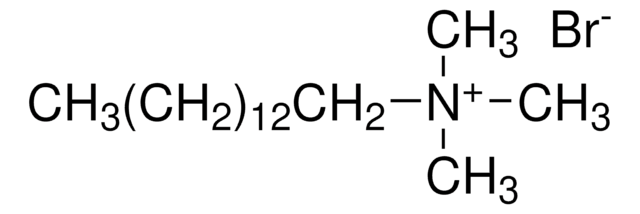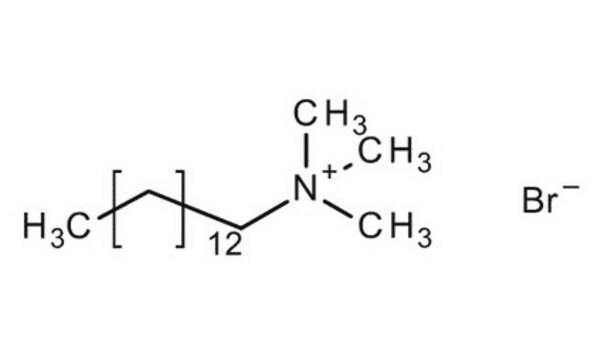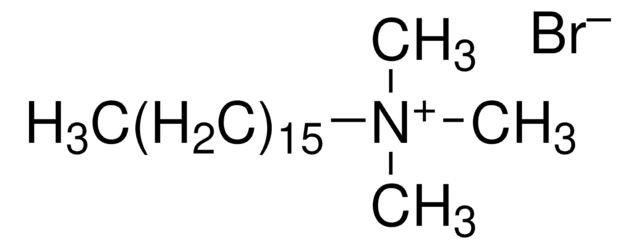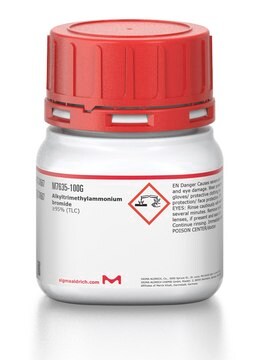87208
Myristyltrimethylammonium bromide
suitable for ion pair chromatography, LiChropur™, ≥99.0% (AT)
Sinonimo/i:
Tetradecyltrimethylammonium bromide, Trimethyl(tetradecyl)ammonium bromide
About This Item
Prodotti consigliati
Descrizione
cationic
Livello qualitativo
Saggio
≥99.0% (AT)
Stato
crystals
Qualità
LiChropur™
PM
micellar avg mol wt 27,000
Numero d'aggregazione
80
tecniche
ion pair chromatography: suitable
CMC
4-5 mM (20-25°C)
Punto di fusione
245-250 °C (lit.)
λ
10 % in H2O
Assorbanza UV
λ: 240 nm Amax: ≤0.08
λ: 250 nm Amax: ≤0.05
λ: 260 nm Amax: ≤0.04
λ: 500 nm Amax: ≤0.02
Compatibilità
corresponds to standard for filter test
Stringa SMILE
[Br-].CCCCCCCCCCCCCC[N+](C)(C)C
InChI
1S/C17H38N.BrH/c1-5-6-7-8-9-10-11-12-13-14-15-16-17-18(2,3)4;/h5-17H2,1-4H3;1H/q+1;/p-1
CXRFDZFCGOPDTD-UHFFFAOYSA-M
Cerchi prodotti simili? Visita Guida al confronto tra prodotti
Descrizione generale
Note legali
Avvertenze
Danger
Indicazioni di pericolo
Consigli di prudenza
Classi di pericolo
Acute Tox. 4 Oral - Aquatic Acute 1 - Aquatic Chronic 1 - Eye Dam. 1 - Skin Irrit. 2 - STOT RE 2 Oral - STOT SE 3
Organi bersaglio
Gastrointestinal tract, Respiratory system
Codice della classe di stoccaggio
11 - Combustible Solids
Classe di pericolosità dell'acqua (WGK)
WGK 3
Punto d’infiammabilità (°F)
Not applicable
Punto d’infiammabilità (°C)
Not applicable
Dispositivi di protezione individuale
Eyeshields, Faceshields, Gloves, type P3 (EN 143) respirator cartridges
Scegli una delle versioni più recenti:
Certificati d'analisi (COA)
Non trovi la versione di tuo interesse?
Se hai bisogno di una versione specifica, puoi cercare il certificato tramite il numero di lotto.
Possiedi già questo prodotto?
I documenti relativi ai prodotti acquistati recentemente sono disponibili nell’Archivio dei documenti.
I clienti hanno visto anche
Il team dei nostri ricercatori vanta grande esperienza in tutte le aree della ricerca quali Life Science, scienza dei materiali, sintesi chimica, cromatografia, discipline analitiche, ecc..
Contatta l'Assistenza Tecnica.












